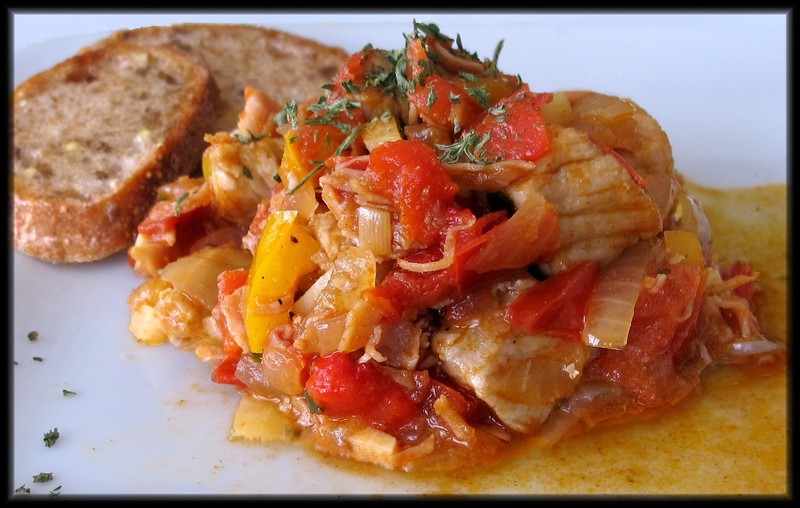If you love to cook and have never taken a course at the Culinary Institute of America, you’ll definitely want to schedule one. Last weekend, I spent a busy five hours at the main campus in Hyde Park, N.Y., immersed in the cuisine of Spain. As our class filed in, we were given paper toques (surprisingly difficult to keep on your head despite the helpful Velcro) and organized into teams of four. We sat on stools admiring the tidy stack of apron, dishtowel and knives on wooden cutting blocks in front of each student.
Chef Anita Eisenhauer began with a presentation on the spirit and energy of Spanish cuisine, likening it to the bullfighting species toro bravo, statues of which dot the Spanish landscape. Many Mediterranean countries share familiar ingredients – olives, garlic, onion, tomato, seafood – while some foods are more closely associated with the Spanish palate: pimentón (paprika), saffron and jambon Serrano (ham). Thumbing through the recipes we would prepare that morning, I was at once delighted and disappointed. Our team would be responsible for making chicken chilindron and stuffed piquillo peppers; however, we would have to be content with merely tasting the rest of the dishes.
But, before anyone lifted a finger, we received a tour of the classroom and detailed instructions about hygiene and safety. Instead of desks we had sinks (hand washing, vegetable washing, dish washing) and storage (pots, bowls, appliances, ingredients), dozens of industrial-strength gas burners and the constant thrum of exhaust fans. Like a television cooking show, our challenge was to have all the dishes ready to serve by lunchtime - let the cooking begin.
Our team started chopping, dicing and slicing for sofrito, a “mother sauce” with countless variations. Often used to flavor other dishes and sauces, its basic elements are onion, red bell pepper and tomato simmered in olive oil until reaching the consistency of thick jam. When done correctly, the vegetables become emulsified in the olive oil, marrying their flavors into a rich paste.
Chef Eisenhauer stopped by our station as we opened a can of piquillo peppers, explaining these are a protected product of Spain and only produced there. Handpicked, slow roasted and peeled by hand, their signature spicy-sweet flavor is certified with a seal of authenticity on every package. She used this as a teaching moment: taste the piquillo so you can discover its unique qualities and appreciate its role in recipes.
The crabmeat stuffing for the piquillo peppers was a variation on a traditional crab cake, with an unexpected addition for someone accustomed to Delaware crab cakes: honey. Once filled, the peppers simmered in a sauce of butter, sofrito, cream, fish stock and more paprika.
Across the station, we meticulously followed the recipe for chilindron that included hot paprika and chicken thighs. You can find other versions that call for cubed lamb in a sauce flavored with sweet paprika. Inspired by the class, when I returned home I made the version in the photo with pork and smoked paprika (watch your kitchen cabinets when you get to the flambé step).
My team thought our chicken dish was supposed to be a kind of soup and were almost smug at how quickly we’d finished cooking it. Fortunately, we escaped embarrassment because Chef stopped by the stove and let us know the sauce of peppers, onion and tomato should be reduced until it becomes just a glaze over the chunks of chicken and ribbons of Serrano ham. Back to the burner.
Meanwhile, Chef began a demonstration of paella by asking why salt should be the first ingredient added to the pan after olive oil. She said the answer – to ward off evil spirits – illustrates just one of the many cultural traditions of Spain. And, paella isn’t actually the name of a dish, but a description of a technique: cooking in a thin, flat-bottomed, two-handled pan over an open fire. A type of short-grain rice known as “bomba” with its low starch content is a key ingredient to successful paella. The sign of a perfectly cooked paella (whether made with seafood, vegetables, rabbit or some combination) is the crunchy crust of rice at the bottom of the pan, a feature so important it has a specific name, socarrat.
One by one, the teams stopped stirring and plated their delicacies, surveying the feast we’d created together. Chef had us begin lunch with cups of molten hot chocolate as a symbol of her wish that we would find our futures as sweet as our first taste of Spain.
Pork Chilindron*
2 T olive oil
1 lb boneless pork, cubed
1 t salt
2 T bourbon
1 sweet onion, chopped
2/3 C chopped roasted red pepper
1 yellow bell pepper, chopped
1/4 C chopped Serrano ham
4 cloves garlic
3 tomatoes, seeded and chopped
2 t smoked paprika
1/2 C chicken stock
parsley for garnish
toasted bread rounds
Heat the olive oil in a skillet over medium high. Toss in the pork cubes and sprinkle with salt. Cook until no longer pink. Add the bourbon and flambé until all traces of fire are gone. Remove pork into a bowl with a slotted spoon; set aside. With heat at medium, add peppers and onion to the skillet; cook until softened. Stir in ham and garlic and cook for about 2 or 3 minutes.
Add the tomatoes, paprika, chicken stock and the pork cubes. Cook over medium low until the liquid is nearly absorbed. Correct seasoning with salt and pepper, to taste. Garnish with parsley and serve on toast rounds. *Recipe adapted from Culinary Institute of America.
The Culinary Institute of America offers a range of courses at three campus locations. Cookbooks featuring the dishes in the course, “Spain and the World Table” as well as other courses are available for purchase. For more details, see the website: www.ciachef.edu.























































